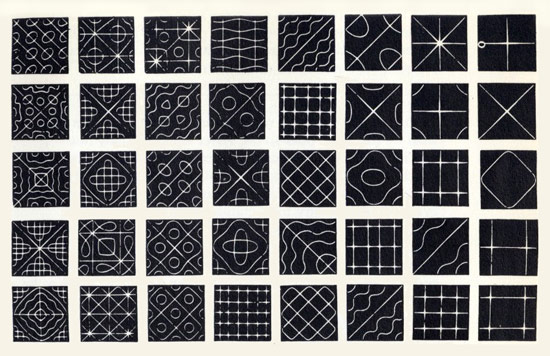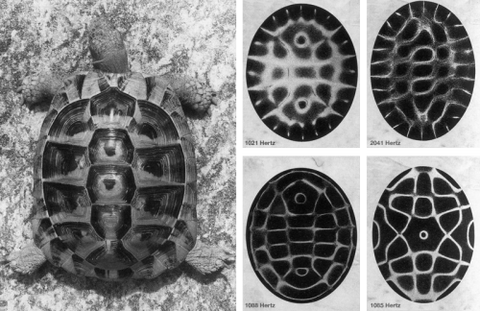Is the visible world around us the primary level of existence? Does it just respond to the rhythms of the invisible world of waves and vibrations? Does sound have the potential to create? These metaphysical questions received their demonstrative confirmation in a scientific discipline known as Cymatics.

What is exactly cymatics and who named it?
Cymatics is the common name for all phenomena that occur as a result of vibrations and waves on the formation of matter. The creator of cymatics, the Swiss physician and natural scientist Hans Jenny (1904 -1972), studied the influence of sound waves on the formation of shapes by exposing various media (powder, liquid) to different frequencies. He also coined the name Cymatics based on the Greek word Kyma (Wave).
Hans Jenny was the first one to associate all wave-related phenomena in a broader sense with cymatics and bring them together in his book. The first volume of Cymatics: The Study of Wave Phenomena was published in 1967. The influence of sound waves on powdered substances and liquids was revealed to the world! Jenny discovered numerous similarities between seemingly unrelated phenomena and noted that in cymatics we can not observe particles apart from vibration. They make one whole.
Cymatics through history
The question arises – for how long has humanity been familiar with shapes that emerge under the influence of different frequencies?
The truth is, cymatics extends throughout human history. In each historical period, people gradually gained knowledge about this incredible phenomenon. The first recorded use of cymatics is attributed, believe it or not, to some African tribes. Also, it was found that in 1000 BC it was used by some Indians as well. How exactly? They used to pour sand on the membranes of the drums and animate it with the help of music during their specific rituals.
Many researchers from the Renaissance onwards, were familiar with cymatics. However, systematic research has never been conducted. Even Leonardo da Vinci himself left a description of this phenomenon in his notes. Galileo Galilei recorded that an oscillating body displayed regular patterns in his 1632 writings called Dialogue Concerning the Two Chief World Systems. In 1680, physicist and musician Robert Hooke took experiments and observed nodal patterns formed by vibrating glass. He made repeating designs with a violin bow on a flour-covered glass plate.
Ernst Chladni, “the father of acoustics”
The work of Hans Jenny was based on the demonstration of acoustic phenomena that Ernst Chladni began to study in the 18th century. German physicist and musician Chladni performed experiments, in a way that he was drawing a bow over a plate or membrane whose surface was covered by sand. As a result of standing waves, geometric figures were formed on the plate – now called Chladni figures. Hans Jenny was the first to use electric oscillators instead of Chladni’s plates. That allowed him to accurately study a certain frequency and its effect on the plate. Experiments have proven how some vibrations can form and organize the matter.
Is nature cymatic?
The beauty and dynamics of the forms that dance on resonant plates have inspired many to step inside the previously invisible world of resonances and vibrations. Some of the shapes are irresistibly reminiscent of the patterns and living beings around us. Images of mirrored biological forms and natural processes, mandalas and other intricate geometric designs, are truly remarkable.
Hans Jenny himself suggested links between cymatics and the natural world of pattern. Indeed, it is impossible not to notice the huge similarities between cymatics structures and different structures in nature. From planetary and cosmological macrostructures to microstructures.
How to explain them?
A biologist Rupert Sheldrake‘s theory of morphogenetic fields is one of the attempts to compile a theory that would explain certain phenomena. It is based on the concept of the existence of morphological fields that represent the collective memory of each of the species. According to Sheldrake, the entire cosmos and its morphology is influenced and determined by an energetic matrix. In it, collective memories and the unconscious of generations of each organism accumulate.
Thanks to German photographer and philosopher Alexander Lauterwasser, and his work and research based on cymatics, it has become even clearer that cymatics images are found in nature. He was a pioneer of using water experiments. His photographs of standing wave patterns are striking. Lauterwasser’s book Water Sound Images offers detailed visual analogues of natural patterns (from the distribution of spots on a leopard to the geometric patterns found in plants and flowers, to the shapes of jellyfish and the intricate patterns found on the shell of a tortoise).
The connection between Cymatics and Music
Visualization of sound allows us to observe what effect music literally has on certain media. Cymatics shows us the sound effects of music. When it comes to seeing the results of cymatics experiments, the words are superfluous. We recommend you to experience the true beauty of cymatics as intended – visually.
- Check out a video by musician Nigel John Stanford, in which he demonstrates his ability to play standard and improvised instruments, all with visual effects that show every sound. See the music!
- In this short video, you can enjoy the beautiful visualization of Japanese vocalist Yantara Jiro‘s voice! It is absolutely stunning. How was this made possible? Thanks to the CymaScope – a new type of scientific instrument that makes sound visible. The color was added so that each musical note was allocated with a specific color.
- Have you ever seen Pink Floyd’s Welcome to the Machine video playing through a cymascope? Now is the time.
- Hans Jenny’s original documentary from the ’60s on cymatics has shown how important sound is in our lives, in our reality, and in the process of creation. Each sound frequency has a specific shape and form. The lower the frequency, the simpler and larger the shapes are. With higher frequency, they become more complex. Documented experiments have been re-released and entitled Cymatic SoundScapes: Bringing Matter to Life with Sound. They are highly recommended and available on YT.
“If you spear a little of your imagination, as you watch this film as it runs, you will see many things that answers many questions, you will see living forms, living amoeba, almost animal like creatures. You will see continents being formed, the Earth itself coming to existence, explosions, erruptions, atomic explosions and bombs. You can see all this and watch it before your eyes. Everything owes it existence solely and completely to sound.”
Peter Guy Manners, MD – from Bringing Matter to Life with Sound documentary
Did you know?
- Artist Björk created projections of cymatics patterns by using bass frequencies on tour for her album Biophilia.
- In oceanography, a lexicon of dolphin language is being created (by visualizing the sonar beams that the dolphin emits).
- Cymatics is used to help the hearing impaired learn to speak clearly.
- When geometric shapes and patterns (such as Fibonacci spirals, crystal structures, hexagrams etc.) created by sound frequencies are mirrored in the design and construction of religious structures, it is referred to as sacred geometry.
Conclusion
Cymatics is a phenomenal field of science and research because it really shows us how this invisible and untouchable sound, even the sound we create while speaking, is able to take a physical form. In other words, cymatics shows us that everything has a vibration, including our bodies.
However, we are left with many questions to ponder on. What is really the cause, and what is the effect? Have the experiments revealed to us the hidden nature of creation? They have certainly piqued the interest and imagination of many. It is no wonder that after so many years, Hans Jenny’s experiments with cymatics are finding a wider audience.
There is still a lot left to be explored. The good thing is – cymatics is accessible to everybody and it offers us a truly unique way to look at sound. Also, we do not all have to be experts to appreciate the hidden beauty of it.
Hans Jenny said it best:
“The more one studies these things, the more one realizes that sound is the creative
principle. It must be regarded as primordial. No single phenomenal category can be
claimed as the aboriginal principle. We cannot say, in the beginning was numbers
or in the beginning was symmetry, etc. They are not themselves
the creative power. This power is inherent in tone, in sound.“






